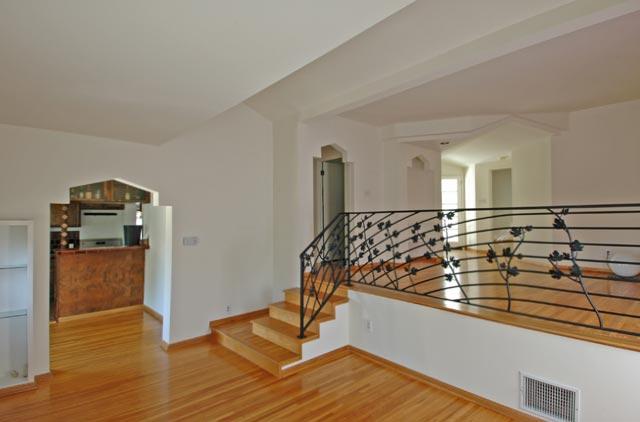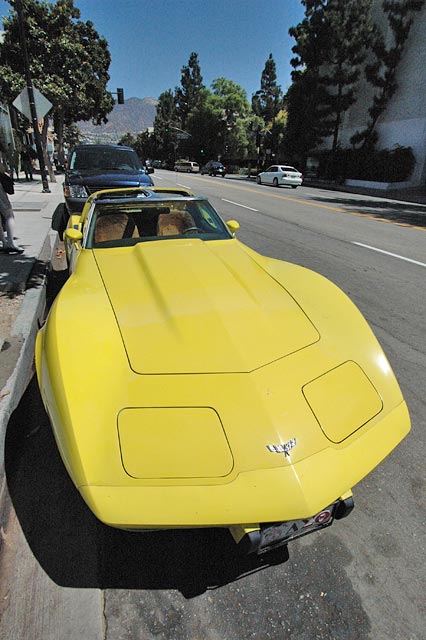

|
When Nikon formed its grand digital SLR strategy back in the late 1990s (before the D1, even) it settled on some fundamental specifications. Chief among them was the size of their first dSLR image chip and the effect on backward compatibility for existing lenses. Did I lose you? Already? DSLRs are re-worked 35mm single lens reflex cameras. But in 1998, the idea of creating an image chip 24 x 36 millimeters big was laughable. That's 864 square millimeters of semiconductor surface. About five times the surface area of the biggest semiconductors you could buy. For comparison, the Pentium III had 106 square millimeters of surface. You want a chip over eight times that big? Whaddaya, nuts? So for this and a wider variety of good solid reasons that aren't as colorful to joke about, they settled into an image chip size of 23.6 by 15.5 millimeters or a surface area of 366 square millimeters, similar to that of a 35mm motion picture camera frame, only keeping the 3:2 aspect we had all come to know and work around. Perhaps you remember from yesteryear that half-frame 35mm cameras were briefly popular when people started realizing how much every click was costing them. Half frame cameras shoot an image about 18 x 24mm (432 sq mm), yadda, yadda. Cinematographers have known for years that big blowups are possible with Nikkor optics on their specialty movie cameras. Some used the same optics that are made for 35mm SLRs. In cinematographer terms, these lenses are a total bargain. You can easily pay $4000+ for a lens that fits your Arriflex. Why mention this? It all has to do with the look of images as they grow in image size at reproduced dimensions that land on our collective retinas. How big is a picture? Isn't that like asking how much does a house cost? I mean pictures come in every size, don't they? As it turns out, the big ones and little ones are exceptions to the rule. And there is a rule: No larger than 28 degrees. Rule of thumb. That's how big it is (width) in the best seat in a movie theater or as an 8x10 at reading distance. And that's how big a well-tempered 18x24mm chunk of film can work when stretched to its approximate limits. When 35mm still format imaging was born, the amount of considered thought that went into the decision went sort of like this:
So they pulled movie film through the camera but rolled eight sprocket holes worth of film for every shot. You know, for the quality. The 36 x 24 mm frame was born. And because grain at the time was more of an issue than it was any time after about 1966, the bigger frames caught on. Nice 8x10 prints. Sometimes larger. Then film grew up, grain went away, sensitivity climbed and f-stops widened. Hand holding a 50mm f/1.4 lens got the shot, but the depth of field was in the tidy bowl. Eventually APS film was developed and the match between what sort of DOF we all saw James Bond running around in and the DOF of our snappy cam were kinda close. (You KNOW that I'm leaving out all sorts of details here, but the factoid remains.) Factoid: APS film size is okay. Technically fine. A good fit with the image size people shoot for PJ and SS. (Photo Journalism and Snap Shots.) The choice of cameras to run it through, the problems of finding a roll of the stuff in mid-vacation, the fact that any APS SLR had lenses that cost just as much as that big 35--none of this helped in its popularity, which basically was --um-- marginal. Nikon's designers were stretched to fill up 366 square millimeters with 2.74 megapixels for their D1, the first dSLR Nikon, but they wisely settled into a sensor footprint about APS film size. So did Canon and Fuji and Kodak and others, before and after Nikon's decision. Where Nikon got it right, some would say, is that they decided to LOCK into this size for the next X-generations of dSLRs. Canon decided to offer a mix of sensor sizes including full frame chips in their top cameras. When you pick up a digital Canon, questions come up: What IS the magnification factor for this camera? 1:1, 1.3:1, or 1.6:1? Kodak produced a string of full-framers and it looks like there will be an enduring argument about whether full frame is a great idea, a good idea, an okay idea, a so-so idea, an irrelevant idea or a dumb idea. Based on the conversation (above) that led to the frame size, it could go either way. By keeping the same F-mount dimensions, older optics could be used on new DSLRs and the trillions of Nikon owners out there would like that. Interior mechanisms could be recycled for use in the dSLRs. Mirrors, meters, viewfinder parts--all could potentially be used. Nikon's APS-size digital sensor specification leads to two main effects. 1. Lenses that produce the same angle of view that show up on 35mm film cameras now display a nice, deeper DOF at the same f-stop. Not a huge amount. More like the one you would see in a movie theater through the lenses that shot the movie. It's not like you can't blur the background with the right optic, eh? 2. Any existing lens feels bigger. It weighs the same, but a 200mm lens behaves like a 300mm lens. Such a bonus! Except, of course, when it comes to wide angle images. Those grow "longer" too. An exotic 18mm super wide angle lens now feels like a more common 28mm wide angle (minus a millimeter). What tele giveth, wide angle taketh away. Theoretically, as the state of the art of image sensor manufacturing got better, this size image chip would grow in pixel count, freedom from noise and image quality in general. It's a gamble, but a reasonable one. I mean, don't semiconductors get better and better all the time? Somewhere in Nikon's engineering facilities, a clandestine group of lens designers were plotting the overthrow of photography as we knew it. They were working on what they call "prescriptions"--the complex designs of optics that include every element, every glass index of refraction and every trick up their sleeves. If you shrink it, DOF will come. You can take a lens design and shrink it. In three dimensions, every shrinking operation that reduces a physical object to 2/3 of its original dimensions will shrink its volume to 29.6% of its original size and weight. For a lens to become 2/3 of its original dimensions, its circle of image coverage shrinks to 2/3 of its original size, its f-stop stays the same and its distance from the image plane shrinks to 2/3 of its original distance. Two of these are good for designers of new optics for Nikon dSLRs, but one of them is bad. That last item--lens placement--could push an adapted design too far into the camera to be practical. You can't have the mirror slapping the back of the lens. Then again, small changes in older designs might work around that. And work around it they did. Now there are several wide zooms competing for your lens dollar, and this 12-24mm f/4 is a veritable hunk. It's not particularly small--notably larger than the kit lens--but it is designed from the ground up to cover only the APS sensor. That means you can't use it on a Nikon 35mm SLR. Or can you?
The Nikkor 17-35mm f/2.8 lens and 18-35mm f/3.5-4.5 AF show similar coverage for full frame cameras and may have contributed wide zoom experience to the team.
The 12-24 is on the right. The f/2.8 is on the left. I think the 12-24 looks like a cross between the other two with some major cleanup in its design. Perhaps this is what evolution looks like at the lens design level. The 12-24 is slightly larger than the Kit lens. Its very front bells out a bit to accommodate huge 77mm filters and its HB-23 tulip lens shade peels out at radical angles. To surprise people with it, hand them the camera with the lens in place, but dialed to 24mm. Then ask them to zoom. You get a lot of "Holy cow"s this way because they won't expect the incredible wide angle to zoom out. It focuses down to about 12 inches (0.3 m), but that's hardly macro with a lens this wide. Coverage ranges from 99° to 61° and the optic produces some degree of barrel distortion.
Shots made with it are wonderfully sharp at all zoom settings. Stop down to f/5.6 and DOF reaches from mere inches away to the horizon. But the big news, as you probably anticipated, is its super-wide status. This is the architect's must-have lens. Interiors, exteriors and exotic points of view fall out of this lens and into your camera every time you pick it up. Better to get a gallery of views than to hear me type in words without pictures:


How to shoot with the 12-24: Get somewhere new. That might seem like an over generalization, but it works for this lens. It takes normal-feeling scenes and pulls them into an exceptional wide angle perspective, and isn't that the fun of a super wide angle image in the first place? So find ways of heightening its already heightened perspective. Get down. Go high. Move it near things that you would normally stand away from. And when the time comes to shoot an architectural form and have the result look normal, keep it level or plan to do some swings and tilts in the digital darkroom.
Recommendations: This is an A-list lens. Its price is ...oh, my God! Well, that's an A-list price, all right. Cough, cough. How am I ever going to explain this to my wife... Later... -iNova
Speaking
of writing, at this hour the new eBook, "dSLR: Nikon D70"
is finally ready. It's out now, and you've already had a minor
taste of it in the images above that accompany the review. A huge--and
I mean HUGE--amount of data, camera specific special techniques,
problem solving procedures, operational short-cuts, headache
prescriptions, shot achieving tips, smart camera tricks and D70
lore you've never seen anywhere else is within its pages. You'll
see. But for now you will have to wait for it. Regards, -iNova Note: Photography and
artwork by Peter iNova. ©2005 Peter iNova, all rights reserved.
© 2004 Peter iNova.
All rights reserved. Do not reprint. Simply add a link to this
page.
|
|||||